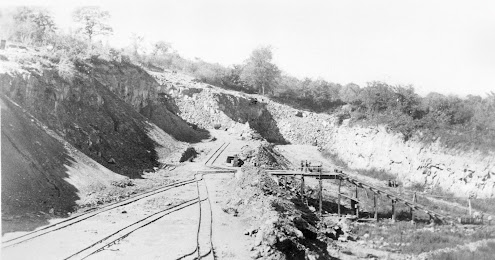Quarry Park
Abandoned Quarry turned Park
Nestled back in the woods off the coast of the Connecticut River lies a once prosperous trap rock quarry. Rightfully so, the town name of Rocky Hill was derived from the abundance of this material in 1843. In the late 1800's, Rocky Hill Stone Company (RHSC) was the first documented entity to begin mining at this location. As 1900 rolled around, RHSC, along with five other Connecticut Quarries, joined forces to create the Connecticut Trap Rock Company. Trap rock, or more commonly known as basalt, is used in various construction practices, namely concrete and roadways. However, in 1901, the James H. Cooke Company had the name changed once again to The Rocky Hill Stone Company.
Mr. William Quinn took to working at the facility in 1907, later becoming superintendent after the late Mr. William Manchester. In the beginning, 2 dump carts and 7 men worked to clean off the top ledge, which dragged on for 7 or 8 years. After that, steam shovels and bulldozers were utilized to complete the operation. Once completed, they began drilling and blasting, first utilizing steam drills that were piped from the base of the quarry. Advancing to air shortly thereafter, they were able to more rapidly begin using dynamite to blast the faces of the ledge off.
For many years, the men pushed the loaded carts by hand around the facility on a system of tracks. As time progressed and business continued profitably, the quarry was then outfitted with a new steam shovel and 2 quarry trucks. The railway being at the base of the quarry allowed the parking of empty freight cars to be loaded as they could be. In 1922 a right of way was purchased that allowed shipments to be hauled out by trucks as well.
A large portion of the workers lived on or around the quarry in makeshift shacks, cooking on fires, and living off of the commissary ran by Tony DeMarko. On March 28, 1935, the New Haven Trap Rock Company purchased the quarry, and it was operational until 1957. From the span of 1925-1944, over 1.5 Million tons of trap rock was sold from this location.
------------------------------------------------------------------------------------------
Quarry Park has a very elaborate system of trails, some of which are quite confusing, however they are all well blazed. A good downloaded or even paper map would be a great resource. To avoid any further confusion or discrepancies about specific trails, this will merely be a documentation without much specific guidance. When you stumble upon the foundations, you will be able find your way around quite easily.
At the base of the hill, you will find yourself among many concrete foundations. These forms once supported a large crusher building, where trap rock was broken down and then loaded onto trains operating on the parallel tracks.
(Courtesy of Rocky Hill Historical Society)
As previously mentioned, this is one of the quarry trucks purchased after years of successful business. Note the old rail tracks that were used previously. In addition, the 2 pillars on either side of the truck, along with 1 that is on the right side of the other track, are still standing today.
This small rail section protruding from the earth is one of the last visible remainders of the original cart system that was utilized in the beginning of the quarry operation.
This building was originally a compressor house. Multiple compressors would provide the air needed up in the quarry to power the drills.
Most likely, based off of similar formations at other locations, these would have held a large water tank which would have supplied the water needed when steam power was being used before transitioning to air.
Up this steep, uneven hill lies a small cave like entrance. It doesn't go far, doing a very small loop before returning you outside. According to Edward Chiucarello, President of the Rocky Hill Historical Society, “I think there was a pulley inside that cave and a cable ran through it then below towards the pond. It must have been used to transport stone. The cable as you probably are aware is laying on the ground below the cave.”
View from above the cave entrance.
Following the blue trail, you will stumble upon the remains of a 1936 era Buick. Not much remains of this vehicle, which was used to power a ski tow rope around 1948 by the Wethersfield Ski Club.
Summary
Quarry Park contains a vast trail system that is suitable for almost anyone. One note is to take caution around the cave area and the lookout landing, as there is quite a lot of loose gravel and trap rock that can slide out from under your feet very easily. This park is home to quite a history of many men's hard work and commitment, and the large quantity of surviving structures allow us to get a glimpse of this.























Comments
Post a Comment
Questions or Comments Always Welcome!